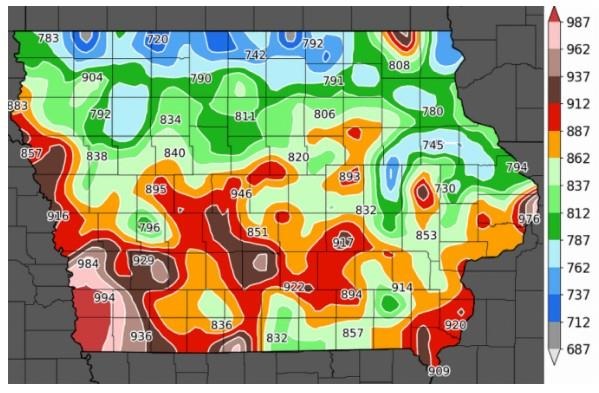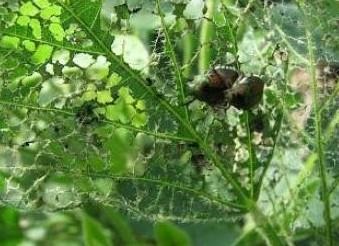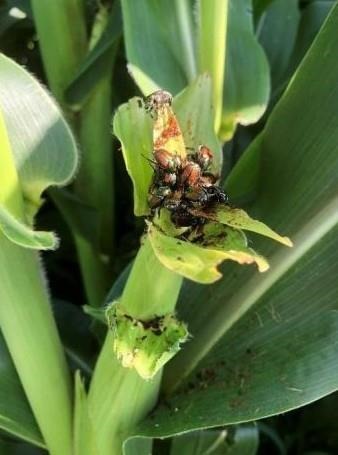By Ashley Dean and Erin Hodgson
This spring, we have had several reports of fields with high numbers of grubs from field agronomists in central Iowa. There are multiple species of white grubs in Iowa, including the Japanese beetle. Recent warm temperatures are accelerating insect development, and with forecasted temperatures, Japanese beetle emergence could begin in southern Iowa counties this week (Figure 1). Japanese beetle adults will begin emergence when approximately 1,030 growing degree days (GDD; base 50°F) have accumulated since January 1 and will continue emerging until 2,150 GDD have accumulated.
 Figure 1. Growing degree days accumulated (base 50°F) in Iowa (as of June 10, 2021). Adults begin emerging around 1,030 degree days. Map courtesy of Iowa Environmental Mesonet, ISU Department of Agronomy.
Figure 1. Growing degree days accumulated (base 50°F) in Iowa (as of June 10, 2021). Adults begin emerging around 1,030 degree days. Map courtesy of Iowa Environmental Mesonet, ISU Department of Agronomy.Identification
Japanese beetle adults are about ½ inch long and metallic green (Photo 1). Their elytra, or hard front wings, are a coppery brown color. A key characteristic is a series of six white tufts of hair on each side of the abdomen.
The sand chafer, or false Japanese beetle, is commonly confused with the Japanese beetle but is a native species that does not damage crops as adults (Photo 1). They are about the same size as Japanese beetles, but they do not have the metallic green coloring and are mostly coppery brown to black.
 Photo 1. The false Japanese beetle (right) is easily confused with the Japanese beetle (left), but it does not have the metallic green color or white tufts of hair. Photos by Jim Kalisch.
Photo 1. The false Japanese beetle (right) is easily confused with the Japanese beetle (left), but it does not have the metallic green color or white tufts of hair. Photos by Jim Kalisch.Plant Injury and Management
Japanese beetles have a wide host range that includes many species of fruit and vegetable crops, ornamentals, and field crops. Feeding will look a bit different depending on the host plant, but since beetles have chewing mouthparts, they will consume plant tissue and cause defoliation. In field crops, adults tend to be denser at the field edge. Additionally, a combination of sex pheromones, aggregation pheromones, and feeding-induced plant volatiles lead to clusters of Japanese beetle adults feeding in one spot. Since feeding can look severe near the edge of fields, it is important to scout the entire field to get a representative estimate of injury.
At this time of year, Japanese beetle adults will likely feed on soybean (among other host plants). On soybean, adults prefer to feed between the leaf veins and can ultimately consume most of the leaf, leaving a skeletonized appearance (Photo 2). If adults are still present in the field, the treatment threshold for Japanese beetle in soybean is 30% defoliation before flowering (R1) and 20% after R1. It is important to note that humans tend to overestimate plant defoliation and that defoliation can be caused by several pest species with chewing mouthparts.
 Photo 2. Japanese beetle adults defoliate soybean and skeletonize leaves, meaning they leave behind the leaf veins. Photo by Mark Licht.
Photo 2. Japanese beetle adults defoliate soybean and skeletonize leaves, meaning they leave behind the leaf veins. Photo by Mark Licht.Japanese beetles do not typically feed on vegetative corn, but adults have a long emergence period and remain active throughout the summer. Once corn reaches VT or R1, consider scouting for Japanese beetle. Adults can feed on both the tassels and silks. Silk clipping can interfere with pollination (Photo 3). Consider a foliar insecticide during tasseling and silking if three criteria are met: there are 3 or more beetles per ear, silks have been clipped to less than ½ inch, AND pollination is less than 50% complete.
 Photo 3. Japanese beetle adults aggregating and feeding on corn silks near the field edge. Photo by Ashley Dean.
Photo 3. Japanese beetle adults aggregating and feeding on corn silks near the field edge. Photo by Ashley Dean.Foliar insecticides are generally effective on Japanese beetles, but adults are highly mobile and could reinfest a field within a few days.
Source : iastate.edu